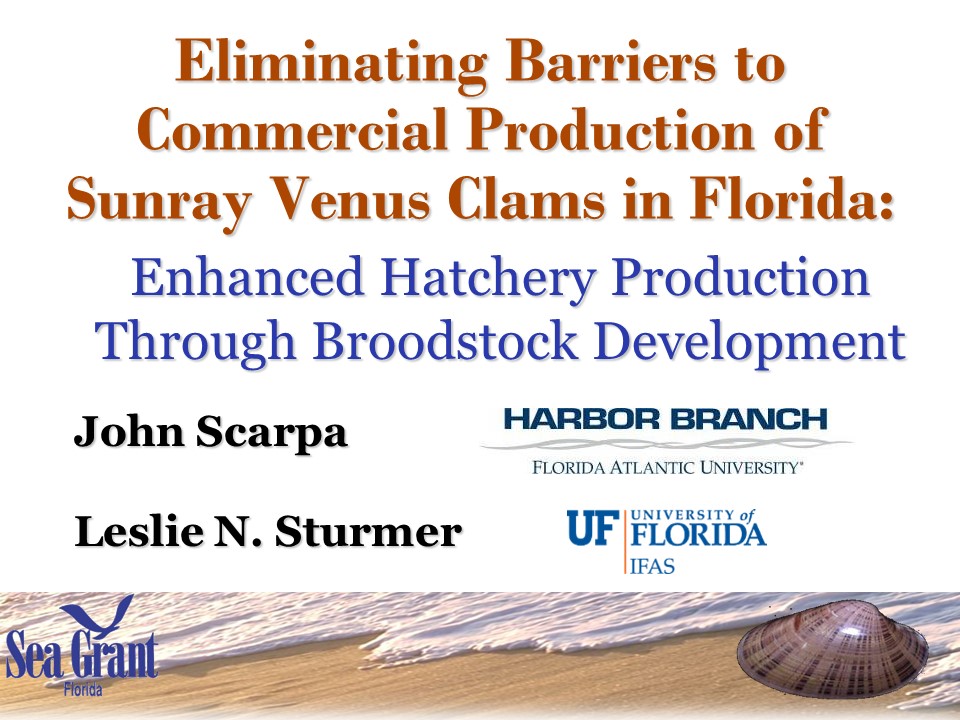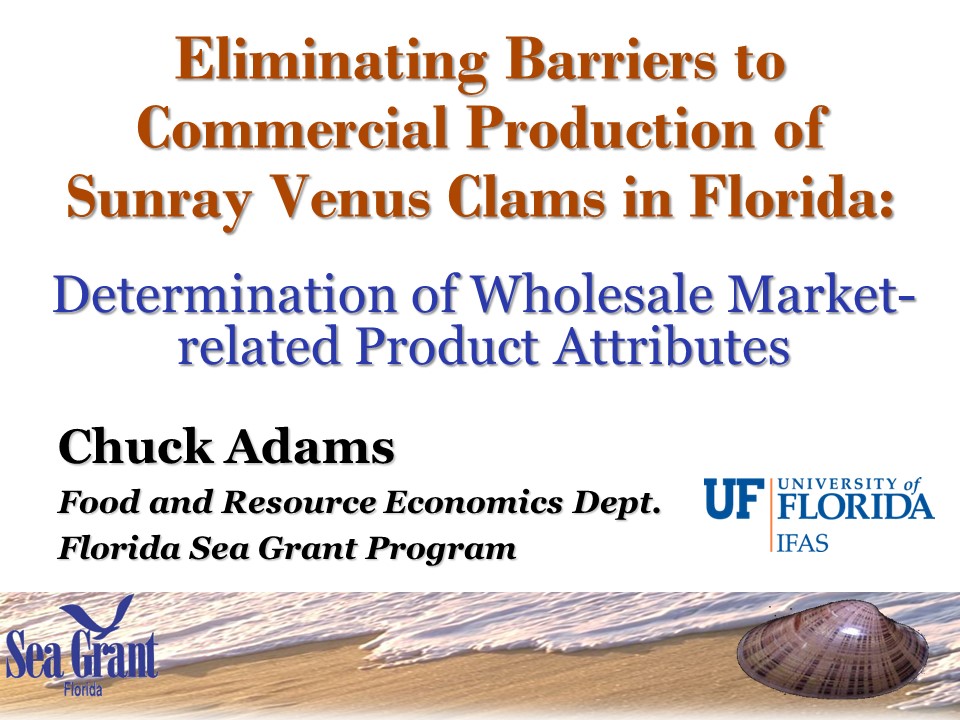Home » Sunray Venus Clams » Florida Sea Grant Projects » Florida Sea Grant Project, 2010-2012

The goal of this project was to eliminate barriers to commercialization of the sunray venus clam as a new aquaculture species, facilitate technology transfer, and promulgate market development through enhanced hatchery production and broodstock development, growout site selection, and determination of wholesale market-related product attributes. Therefore, the objectives were to: 1) Create initial founder broodstock lines for Florida hatcheries; 2) Demonstrate to hatchery operators the proper development of broodstock for seed production; 3) Determine production performance of sunray venus clams for growout culture at multiple existing commercial lease areas; 4) Establish a relationship between bottom sediments (substrate) and sunray venus clam productivity at lease areas using a soils-based approach; 5) Define a) soil and b) salinity preferences for selection of lease sites for sunray venus clam culture; 6) Determine the sensory, shelf life, and nutritional profiles of cultured sunray venus clams; and 7) Examine product attributes of sunray venus clams with respect to wholesale market and distribution standards for molluscan shellfish.
Broodstock Development: Separate lines of broodstock sunray venus clams collected from Alligator Harbor (Franklin County), Seahorse Key (Levy County), and Anna Maria Island (Manatee County) were created using multiple parents in a factorial mating scheme to capture genetic diversity. The proper development of sunray venus clam broodstock for seed production was demonstrated to commercial hatchery personnel through workshops to ensure they do not initiate genetic bottlenecks or greatly limit genetic diversity in their product and future lines for selective breeding.
Growers Trials at Commercial Leases: Production performance was evaluated at 20 commercial leases and 4 test sites by providing 210,000 seed to 18 growers in four counties. Each grower standardized three bottom bags by stocking at 50/ft² and harvesting at ~12 months. The 2010-11 growout trials yielded a range of results with survivals of 4 to 71%, while harvest sizes ranged from 40 to 52 mm in shell length (SL) and 10.3 to 21.9 grams (21-44/lb) in weight. Shell deformities (1-9%) were low at all sites. In the 2011-12 trials, survivals were similar to the previous year (10-61%) and harvest sizes were slightly larger (48-58 mm SL, 11.3-25.5 grams [18-41/lb] total weight). Again, shell deformities (0-5%) were low at all sites. Leases in Dog Island (Levy County) and North Pine Island (Lee County) produced the largest sunray venus clams (23-25.5 g weight), while leases in Alligator Harbor (Franklin County), Dog Island, and North Pine Island had the highest survivals (61-71%) in both trials. To examine the relationship between bottom sediments and sunray venus productivity, soil properties at each site were measured at plant for particle size and organic matter. Sand content and bulk density (i.e., soil mass per unit volume) were determined to have a significant positive correlation to survival, while organic matter, silt, and clay content were negatively associated with survival. For those leases that supported commercially acceptable survival (>60%), sand content exceeded 93% and organic matter was less than 1.5%.
Soil Properties for Growout: Soil characterization for culturing the sunray venus clam were determined from in situ mesocosm studies in which replicated 3-gallon buckets of various soils were stocked with juveniles and placed at the UF research lease for six months. In the first study, sunray venus clams had higher survival, less deformities, and grew larger in soils with >94% sand and <1% organic matter content when compared to sunrays grown in soils of 82% sand and 4% organic matter content. To better differentiate preferences of the sunray venus clam for substrate type, a second bucket study was conducted with six engineered soils that ranged from 85-100% sand and 0-15% fines (silt and clay). The buckets were each stocked with 40 juveniles (average: 16.3 SL, 0.7 g weight). After six months, results indicated no significant differences among soil treatments in growth (34.8-36.8 mm SL, 5.2-6.2 g weight), survival (86-96%), or shell deformity (0-2.7%). However, the highest growth and survival were found in the 91% sand treatment, while the lowest survival and highest rate of shell deformity were found in the 85% sand treatment.
Sub-adult Salinity Preferences: Lab-based experiments were performed to determine optimal salinity for growout of sunray venus clams. Sub-adults (35 mm SL, 6.6 g total weight) were placed in triplicate tanks containing 15 liters of 16, 24, 32, and 40 ppt saltwater for 28 days. Mortality was greatest in the 40 ppt treatment (30%), least in the 16 and 24 ppt treatments (0%), and minimal in the 32 ppt treatment (7%). Sunray venus tolerated an 8 ppt step change in salinity with minimal or no mortality and fared well with a 16 ppt step change in salinity, which is a good characteristic for culturing in areas that may experience salinity changes. A second experiment examined the effect of salinity acclimation on salinity tolerance. Sunray venus acclimated to salinities from the prior experiment were subjected for 18 days to different salinity treatments in duplicate as follows: 16 to 12, 14 and 16 ppt; 24 to 12, 24 and 40 ppt; 32 to 12,16 and 32 ppt; and 40 to 16 and 24 ppt. Sunray venus acclimated to 16 ppt were found to survive well (83 and 88%) when exposed to slightly lower salinities (12 and 14 ppt). Sunray venus experiencing a salinity change of 12 ppt or greater than 50% of the initial salinity had no survival regardless of initial salinity acclimation, but salinity minimum is still probably near 10 ppt. Sub-adults in growout may be more resilient to lower salinities (12-16 ppt) when acclimated to lower salinities and if the change is gradual versus abrupt.
Sensory, Shelf Life and Nutritional Profiles: A sensory evaluation of the sunray venus clam was conducted to describe, or profile, their characteristics. The grayish-brownish tones of the shell turn after cooking an attractive peach to orange color along with the radiating pattern of the glossy-smooth shell. The edible meat is a creamy white and lighter in color than hard clams. Its plumpness and volume (i.e., almost full half-shell) can be used to distinguish and market the clam as ratings were very high for these attributes. There was an interesting range in the ratings for umami basic taste, which has not been previously described for clams. In addition, the sunray venus clam had a distinguishable seaweed and metallic-like flavor and the meat texture was very firm. During the study, there was no detection of “grit” in samples tested. The shelf life of the sunray venus clam was documented during the summer and winter to account for the influence of water temperatures at harvest. Survival of summer-harvested sunray venus in refrigerated storage (<45°F) was 86-92% at 8 days and 90-94% at 14 days for winter-harvested sunray venus. An unanticipated observation was the tendency of this clam to remain closed when approaching mortality. This is in contrast to other clam species and even the sunray venus clam during the first week in storage. Therefore, it was recommended that retailers conduct a daily sensory evaluation of sunray venus clams nearing the shelf life expiration date (7 days after harvest in the summer and 12 days after harvest in the winter) to ensure product is suitable for consumption. A nutritional profile was determined for sunray venus clams in which a single 3-ounce (85 g) serving provided 9 grams of protein. The low fat content (<1%) was composed primarily of polyunsaturated fat (68%, with 50% omega-3 fatty acids) and the remainder (32%) as saturated fat. The level of cholesterol was about 25 mg per serving. The most important nutritional feature was that a serving provided a good complement of minerals and vitamins. Sunray venus clams had an average sodium content of 360 mg per 100 grams.
Wholesale Market Product Attributes: A facilitated mail survey of primary wholesalers and their “downstream” clients was conducted to evaluate cultured sunray venus clams on the basis of product attributes and requirements for product handling. Live sunray venus clams and a “survey kit” were sent to 33 wholesale dealers, of which 29 responded to the survey. The majority of survey respondents were distributors, located in the southeast U.S., had annual seafood sales exceeding $10 million, and reported molluscan shellfish sales as being the greatest percentage of annual sales. Dealers and clients were asked to rate the shellstock product across several attributes. Most attributes received relatively high ratings, the lowest being given for the taste of raw product and texture. Half of the survey respondents were not able to detect any grit in the product, while 47% detected ‘some grit’. Meat yield was suggested to be ‘About as expected’ or ‘More than expected’ by 56% and 44% of respondents, respectively. Approximately 70% of respondents indicated that shell thickness was ‘Just right’, while 90% found shelf life to be ‘Acceptable’. In addition, most respondents suggested few concerns regarding handling, storage, packaging or shipping of sunray venus clams. Survey recipients were asked to provide perceptions on the potential demand. About half (46%) indicated they ‘Could sell some’, while 42% suggested a ‘High market demand’ will exist. Respondents suggested that of the key product attributes for sunray venus clams, the most attractive marketable attributes would be taste of cooked product, shell appearance, and meat yield. Dealers also responded that the market may likely exist year-round, with potentially significant volume of sales being possible. The overall assessment of sunray venus clams by wholesale dealers and their clients was extremely favorable.
For more information about this project, view the final report and other project reports below, as well as presentations made at state, regional, and national meetings.
Eliminating Barriers to the Commercial Production of Sunray Venus Clams in Florida: Final Report 29 pages (pdf file)
Wholesale Market Survey for Sunray Venus Clams 11 pages (pdf file)
Development of Product Standards for Cultured Sunray Venus Clams 12 pages (pdf file)
Enhanced Hatchery Production through Broodstock Development
Presented at the Florida Clam Industry Workshops, Fort Pierce and Cedar Key, FL
Proper Development of Clam Broodstock for Seed Production
Presented at the Florida Clam Industry Workshops, Fort Pierce and Cedar Key, FL
Evaluation of Sites for Growout Culture of the Sunray Venus Clam
Presented at the Florida Clam Industry Workshop, Cedar Key, FL and Aquaculture 2013, Nashville, TN
Salinity Tolerance of Sub-adult Sunray Venus Clams pdf file
Presented at the Florida Clam Industry Workshop, Cedar Key, FL and Aquaculture America 2012, Las Vegas, NV
Salinity Acclimation Tolerance of Sub-adult Sunray Venus Clams pdf file
Presented at the Florida Clam Industry Workshop, Cedar Key, FL and National Shellfisheries Association Annual Meeting,
Seattle, WA
Characterization of Soil Properties for Culturing the Sunray Venus Clam
Presented at the Florida Clam Industry Workshop, Cedar Key, FL and National Shellfisheries Association Annual Meeting, Jacksonville, FL
Sensory Profile, Shelf Life and Nutritional Attributes of the Sunray Venus Clam
Presented at the Florida Clam Industry Workshop, Cedar Key, FL and Aquaculture 2013, Nashville, TN
Wholesale Market-related Product Attributes of the Sunray Venus Clam
Presented at the Florida Clam Industry Workshop, Cedar Key, FL and Aquaculture 2013, Nashville, TN
Leslie Sturmer, University of Florida IFAS, Shellfish Aquaculture Extension
John Scarpa, Harbor Branch Oceanographic Institute at Florida Atlantic University
Chuck Adams, University of Florida IFAS, Food Resource and Economics Department
Steve Otwell, University of Florida IFAS, Food Science and Human Nutrition Department
Todd Osborne and Rex Ellis, University of Florida IFAS, Soil and Water Sciences Department
LeRoy Creswell, University of Florida IFAS, Florida Sea Grant Extension